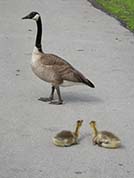Holiday season – View holiday hours for City of Winnipeg facilities and services from December 24 to January 1.

Current goose management techniques
Urban Goose Working Group
The City of Winnipeg belongs to the Urban Goose Working Group. The group is a collaboration between the Government of Canada, the Province of Manitoba, the City of Winnipeg, and the Winnipeg Airport Authority. The Urban Goose Working Group's goal is to reduce risks to human health and safety caused by Canada geese in the City of Winnipeg.
Since 2011, the Urban Goose Working Group has reduced the number of geese nesting and feeding along Kenaston Boulevard:
Geese nesting and feeding near roadways can cause traffic hazards. Groups of geese feeding near and crossing roadways can result in potentially dangerous situations when motorists suddenly swerve or brake to avoid striking geese. High speeds on Kenaston can make this behaviour particularly risky for both motorists and the geese. Egg removals along Kenaston Boulevard result in a reduction in the goose population in the immediate vicinity and increased traffic safety.
Population Monitoring

Resident geese are counted at all retention ponds in the City of Winnipeg each July. Since 2012, the number of summer resident geese has varied each year. Typically, there are between 2000 and 3000 adult geese and goslings at retention ponds within the City of Winnipeg each summer. The purpose of these counts is to determine where resident goose populations may have the greatest impact on their surroundings.
The City of Winnipeg and members of the Urban Goose Working Group also count migratory geese. These counts determine how many geese use the city and surrounding areas during migration. For migratory counts, geese are counted on two separate days that line up with peak migration. This effort requires the help of all members of the Urban Goose Working Group as the counts occur in a 3-hour window to prevent double counting. Peak migratory counts have varied between 50,000 and 120,000 geese since counts began in 2012.
